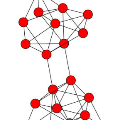The increasing demand for diverse emerging applications has resulted in the interconnection of multi-access edge computing (MEC) systems via metro optical networks. To cater to these diverse applications, network slicing has become a popular tool for creating specialized virtual networks. However, resource fragmentation caused by uneven utilization of multidimensional resources can lead to reduced utilization of limited edge resources. To tackle this issue, this paper focuses on addressing the multidimensional resource fragmentation problem in virtual network embedding (VNE) in MEC systems with the aim of maximizing the profit of an infrastructure provider (InP). The VNE problem in MEC systems is transformed into a bilevel optimization problem, taking into account the interdependence between virtual node embedding (VNoE) and virtual link embedding (VLiE). To solve this problem, we propose a nested bilevel optimization approach named BiVNE. The VNoE is solved using the ant colony system (ACS) in the upper level, while the VLiE is solved using a combination of a shortest path algorithm and an exact-fit spectrum slot allocation method in the lower level. Evaluation results show that the BiVNE algorithm can effectively enhance the profit of the InP by increasing the acceptance ratio and avoiding resource fragmentation simultaneously.
翻译:随着不断涌现的多元化应用需求,多接入边缘计算(MEC)系统通过城域光网络进行互连。为满足这些多样化的应用,网络切片已成为创建专业化虚拟网络的流行工具。然而,由于多维资源的不均匀利用所导致的资源碎片化可能会导致有限边缘资源的利用率降低。为解决这个问题,本文旨在解决MEC系统中虚拟网络嵌入(VNE)中的多维资源碎片化问题,以最大化基础设施提供商(InP)的利润。MEC系统中的VNE问题转化为一个双层优化问题,考虑了虚拟节点嵌入(VNoE)和虚拟链路嵌入(VLiE)之间的相互依存关系。为了解决此问题,我们提出了一种名为BiVNE的嵌套双层优化方法。在上层中,VNoE使用蚁群算法(ACS)来解决,而在下层中,VLiE使用最短路径算法和精确配套频谱分配方法的组合来解决。评估结果表明,BiVNE算法可以通过同时提高接受率和避免资源碎片化来有效增强InP的利润。

